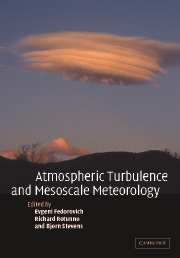Book contents
- Frontmatter
- Contents
- Preface
- Douglas K. Lilly: a biography
- Part I Atmospheric turbulence
- Part II Mesoscale meteorology
- 6 Model numerics for convective-storm simulation
- 7 Numerical prediction of thunderstorms: fourteen years later
- 8 Tropical cyclone energetics and structure
- 9 Mountain meteorology and regional climates
- 10 Dynamic processes contributing to the mesoscale spectrum of atmospheric motions
- Appendix A Douglas K. Lilly: positions, awards, and students
- Appendix B List of publications by Douglas K. Lilly
- Index
- Plate section
10 - Dynamic processes contributing to the mesoscale spectrum of atmospheric motions
Published online by Cambridge University Press: 04 August 2010
- Frontmatter
- Contents
- Preface
- Douglas K. Lilly: a biography
- Part I Atmospheric turbulence
- Part II Mesoscale meteorology
- 6 Model numerics for convective-storm simulation
- 7 Numerical prediction of thunderstorms: fourteen years later
- 8 Tropical cyclone energetics and structure
- 9 Mountain meteorology and regional climates
- 10 Dynamic processes contributing to the mesoscale spectrum of atmospheric motions
- Appendix A Douglas K. Lilly: positions, awards, and students
- Appendix B List of publications by Douglas K. Lilly
- Index
- Plate section
Summary
Introduction
This chapter is a review of recent developments in our understanding of the mesoscale spectrum of atmospheric motions. This topic has received considerable attention in the two decades since Doug Lilly's (1983) seminal paper on stratified turbulence. The subject has not been without controversy as atmospheric scientists and fluid dynamicists have debated the relative contributions of turbulent processes and internal waves to the spectrum of atmospheric motions. In this review we focus attention on the lower atmosphere, which is of primary interest to meteorologists.
Several papers that preceded Lilly's work are worth noting. Gage and Jasperson (1979) noted the variability in high-resolution sequential wind observations taken with a novel balloon sounding system. Gage (1979) placed these observations in a turbulence context and attributed much of the variability in these observations to two-dimensional turbulence arguing that the scales were too large to be associated with three-dimensional turbulence. Dewan (1979) examined stratospheric spectra and concluded that while the spectra had many of the features generally associated with turbulence they could also be explained by a spectrum of internal waves. Similar arguments were made by VanZandt (1982) who argued for a universal spectrum of internal waves analogous to the Garrette-Munk spectrum of internal waves in the ocean (Garrett and Munk, 1972).
The importance of an improved understanding of mesoscale variability has recently become evident as increasing importance is attached to the assimilation of diverse atmospheric data into numerical models. The current situation is summarized by Daley (1997) who argues that model forecasts depend critically on the assimilation of data with a specified error covariance.
- Type
- Chapter
- Information
- Atmospheric Turbulence and Mesoscale MeteorologyScientific Research Inspired by Doug Lilly, pp. 223 - 264Publisher: Cambridge University PressPrint publication year: 2004
- 2
- Cited by



